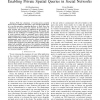CSE
2009
IEEE
14 years 6 months ago
2009
IEEE
—Employees using social network sites (SNS) at workplace is a fact. As companies are further embracing social media, how if at all does this practice affect the work dynamics? Wh...
CSE
2009
IEEE
14 years 6 months ago
2009
IEEE
—With the abundance of location-aware portable devices such as cellphones and PDAs, a new emerging application is to use this pervasive computing platform to learn about the wher...
CSE
2009
IEEE
14 years 6 months ago
2009
IEEE
—Location-based Social Networks (LSNs) allow users to see where their friends are, to search location-tagged content within their social graph, and to meet others nearby. The rec...
CSE
2009
IEEE
14 years 6 months ago
2009
IEEE
This paper describes a method of applying a reinforcement learning artificial intelligence to categorize audio files by mood based on listener response during a performance. The s...
CSE
2009
IEEE
14 years 6 months ago
2009
IEEE
—We introduce a new data set which contains both a self-declared friendship network and self-chosen attributes from a finite list defined by the social networking site. We prop...
CSE
2009
IEEE
14 years 6 months ago
2009
IEEE
CSE
2009
IEEE
14 years 6 months ago
2009
IEEE
—We introduce a novel set of social network analysis based algorithms for mining the Web, blogs, and online forums to identify trends and find the people launching these new tren...
CSE
2009
IEEE
14 years 6 months ago
2009
IEEE
—Social Network Analysis (SNA) has evolved as a popular, standard method for modeling meaningful, often hidden structural relationships in communities. Existing SNA tools often i...
CSE
2009
IEEE
14 years 6 months ago
2009
IEEE
Interobserver reliability and reproducibility are well known problems in experimental research within the social and behavioural sciences. We propose the use of formal techniques ...
CSE
2009
IEEE
14 years 6 months ago
2009
IEEE
—We describe a semantic imitation model of social tagging that integrates formal representations of semantics and a stochastic tag choice process to explain and predict emergent ...


